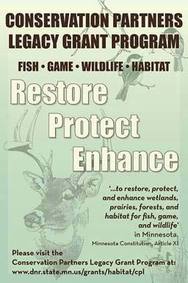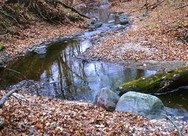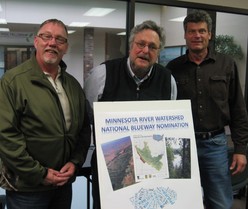 The Minnesota Dept. of Natural Resources (DNR) is accepting applications for its Conservation Partners Legacy (CPL) grant program. This program funds conservation projects that restore, enhance, or protect forests, wetlands, prairies, or habitat for fish, game, and wildlife in Minnesota.
Grant requests may range from $5,000 to $400,000, with a maximum total project cost of $575,000. Nonprofit organizations and government entities are eligible to apply, and a 10-percent match of non-state funds is required. Funded by the Outdoor Heritage Fund, this program exc\pects to have $3.49 million for Fiscal Year 2014 grants.
The application system for both the Traditional Over 25,000/Under 25,000 cycle and the Expedited Conservation Projects (ECP) cycle opened Aug. 1, 2013:
- New this year is the dedication of $500,000 to projects located within the seven-county metro area or within a city of 50,000 people or greater. Apply through the O25K/U25K cycle for these funds. The traditional application cycle closes Sept. 16.
- For the ECP grant cycle, $1 million is available. This program funds projects up to $50,000 on public lands or waters open to all seasons of hunting and fishing. The ECP application cycle is open continuously through May 14, 2014, or until all funds are awarded. Apply by Sept. 11 for the first round of ECP funding.
The Request for Proposal and Program Manual is now posted for both the Traditional Cycle and ECP. For more information, send an email to lscplgrants.dnr@state.mn.us.
|
 The Minnesota Board of Water and Soil Resources (BWSR) will hold a competitive grant application round this fall using funds appropriated from the Clean Water Land and Legacy amendment during the 2013 legislative session. The Board will consider authorizing the grant program at its Aug. 29 meeting. If authorized, the grant application period will run from Sept. 3 through Oct. 4 with funds awarded at the Board’s January meeting.
Training materials on the application process and details of the request for proposals are being developed. Web-based trainings are planned for Aug. 21 and 22. Online registration for the training is now open.
Three funding categories from previous years will be requesting grant applications:
- Clean Water Assistance;
- Accelerated Implementation; and
- Community Partners Conservation Program.
BWSR is also working to incorporate the Minnesota Department of Agriculture’s BMP Loan program and the Minnesota Department of Health’s Well Sealing program into the Clean Water Competitive Grants Program.
|
One of the roles of the MPCA is to assess the condition of Minnesota’s groundwater. Clean groundwater is vital to the state of Minnesota. Groundwater supplies drinking water to about 75 percent of all Minnesotans and almost all of the water used to irrigate the state’s crops. The inflow of groundwater also is important to Minnesota’s streams, lakes and wetlands.
In a new groundwater report, MPCA primarily looked at monitoring data from 2007-2011 that included traditional pollutants known to adversely affect groundwater such as nitrate, chloride and volatile organic compounds (VOCs or chemicals that participate in forming ozone). The report also included some newly-recognized pollutants, such as medicines, insect repellents, and fire retardants. The effects of these new pollutants, which are often referred to as contaminants of emerging concern or CECs, onto human and aquatic life are not fully understood at this point.
Highlights from “The Condition of Minnesota’s Groundwater, 2007-2011” include:
-
Shallow groundwater in the Twin Cities Metropolitan Area (TCMA) is impacted by high chloride concentrations with 27 percent of the TCMA monitoring wells in the sand and gravel aquifers having concentrations that were greater than drinking water guidelines set by EPA.
-
If chloride continues to increase in the groundwater, additional waters will likely violate drinking water and water-quality standards in the future.
-
Nitrate contamination generally has not changed over the last 15 years; however concentrations remain high in certain parts of the state.
-
The highest nitrate concentrations occurred in the aquifers in Central and Southwestern Minnesota.
-
CECs were detected in about one-third of the sampled wells in 2010. The most-frequently detected chemicals were the fire retardant tris phosphate, the antibiotic sulfamethoxazole, and bisphenol A and tributyl phosphate. No concentrations violated any applicable human-health guidance set by the state of Minnesota.
Monitoring is ongoing with additional wells being installed to increase the breadth of the monitoring network. This work will serve the state well into the future by detecting contamination problems that occur along with developing and tracking groundwater quality trends. To view the executive summary and full report on the condition of Minnesota’s groundwater, visit the MPCA’s Groundwater in Minnesota webpage.
 The U.S. Environmental Protection Agency recently approved the Total Maximum Daily Load (TMDL) report for Bluff Creek in Chanhassen, a small tributary of the Lower Minnesota River.
The TMDL report is part of a nationwide effort under the federal Clean Water Act to identify and clean up pollution in streams, rivers and lakes. A TMDL report is a scientific study that calculates the maximum amount of a pollutant a water body can receive and still meet state water quality standards.
Bluff Creek begins at the headwaters located near Trunk Highway 41 on the north and discharges into the Minnesota River Floodplain. The catchment area at the outlet of Bluff Creek in Rice Lake is 6.4 square miles, the total length of the main stem is 7.5 miles, and the creek is moderate to fully entrenched for most of its course. The watershed's upper reaches are a mix of forested upland and meadow. The middle reach is a mix of land uses and is rapidly urbanizing. The lower reach is steep valley walls, is highly sinuous, and lined with trees.
The MPCA lists Bluff Creek as impaired for elevated turbidity levels and for impaired biota due to a low fish Index of Biotic Integrity (IBI) score.
Primary sources of total suspended solids within this watershed are stream bank and bluff erosion, as well as poorly vegetated ravines and gullies. These sources of sediment are mobilized by stormwater runoff from the watershed under high flow conditions. For the creek to meet state water quality standards, significant reductions in sediment loads will be needed, as detailed in the TMDL report.
|
The MPCA is accepting comments through Aug. 26 on proposed amendments to state rules regulating animal feedlots.
The MPCA proposes to amend these rules to address law changes made by the Minnesota Legislature in the 2011 special session. The MPCA is also taking this opportunity to remove obsolete rule requirements, address other law changes adopted since Chapter 7020 was revised in 2000, and provide clarification to certain existing rules in Chapters 7020, 7001 and 7002.
The MPCA regulates the collection, transportation, storage, processing and utilization of manure and process wastewaters associated with the operation of animal feedlots. Since the 1970s, the MPCA has regulated feedlots primarily through permits, including National Pollutant Discharge Elimination System (NPDES) permits, State Disposal System (SDS) permits, and construction short form and interim permits, the latter two also issued by counties under delegation from the MPCA.
The proposed amendments include:
- incorporation of new statutory language eliminating the need to hold an NPDES permit except as required by federal law, while maintaining the requirement for larger feedlots to hold an SDS permit;
- incorporating other new statutory requirements enacted since the feedlot rules were last revised, including new statutory pasture definitions and 10-year terms for SDS permits;
- clarification of administrative requirements for permits, including the processes for issuance or denial of permits by delegated counties and modification of permits; and
- removal of obsolete language, such as provisions governing older forms of permits, and expired transitional requirements, such as the “open lot agreement.”
To review the proposed rule amendments and the Statement of Need and Reasonableness, together with the official public notice, which explains how interested persons can comment on the proposed amendments, go to the MPCA’s Public Notices webpage. Other rule documents are on the agency’s Feedlot Rulemaking webpage.
 Years of effort by groups and individuals working to improve the Minnesota River could receive a boost from a national recognition program highlighting major river basins. The Minnesota River Watershed Alliance has nominated the Minnesota River to become a “National Blueway.”
The U.S. Dept. of Interior established the National Blueways System in 2012 to promote a network of nationally significant rivers and their watersheds that are highly valued as economic, recreational, social, and ecological assets. The Connecticut River spanning four states in New England was the first to receive National Blueways designation.
The Minnesota River Watershed Alliance (MRWA) is a watershed-wide network of individuals from private organizations and public agencies, and citizens who meet quarterly and work on projects that support and benefit the Minnesota River basin. More than 50 public and private organizations from all sectors supported the nomination.
Recently, opposition to the Blueways program surfaced in Arkansas and Missouri, where the White River had been the second to receive the designation. Since local support and control is paramount, the Dept. of Interior accepted a request to withdraw the White River designation, and placed the program temporarily on hold. In response, the MRWA is expanding efforts to show local support, and disseminate accurate information.
A delegation from the Blueways nomination team will meet at noon, Monday, Aug. 26 at the Joseph Nicollet Tower and Museum in Sisseton, SD. There will be a visit to the Little Minnesota River source at Sica Hollow State Park, followed by an open house/community listening session from 4:30 to 7:30 p.m. at the City Hall Community Room in Sisseton.
For more information about the event, contact Patrick Moore at riverartisan@gmail.com, or 320-841-1487.
For more information, visit the Minnesota River nomination website. In the photo above, alliance memebrs Brad Cobb and Patrick Moore, with John Schueller , Redwood County commissioner and Minnesota River Board chairperson, show a poster on the nomination effort.
|
The Minnesota Erosion Control Association (MECA) recently produced an educational video on Perimeter and Sediment Control. During construction, perimeter and sediment control can trap soils that are eroding from disturbed areas. This short video program provides tips and instructions on various products available as well as installation tips for capturing sediment so it does not leave a construction site. This program was created by MECA with funding provided by the Minnehaha Creek Watershed District and is intended for contractors who work on small construction projects.
The Stearns County Soil and Water Conservation District will hold a workshop on “Stormwater Management Using Permeable Materials” Thursday, Aug. 29, from 10 a.m.-2 p.m. at the county service center, 3301 County Road 138, Waite Park, Minn. This training is intended for city, county and township zoning staff, state agency staff, consultants, vendors and others interested in stormwater treatment options.
This is no fee for the training but pre-registration is required by Aug. 23 because of limited space. RSVP by contacting Greg Berg, Stearns County SWCD Shoreland Specialist, at 320-251-7800 (ext. 143) or greg.berg@mn.nacdnet.net.
“From the River to the Tap: Making the Mississippi into Drinking Water” will be the topic for the Mississippi River Forum on Friday, Aug. 23. Participants will gather for a special meeting and tour from 8-9:30 a.m. at Minneapolis' water treatment plant in Fridley (note location change).
Participation in this event is limited, and RSVPs to Lark Weller of the National Park Service are required in advance.
 At this year’s State Fair Aug. 22-Sept. 13, take the plunge at the Eco Experience and learn all about the lakes, rivers, drinking water, and groundwater that make Minnesota great.
New this year, a 200-square-foot map will feature a satellite view of the Ramsey-Washington Metro Watershed District, with imagery so detailed that metro visitors will be able to find their own houses and locate places in the watershed where residents are working to improve water quality.
Also at Eco Experience:
- Young artists selected as finalists in the H2O for Life competition will have their winning posters on display. Budding water scientists will have a chance to try their hand at testing clarity of water from Lake Phalen and see Minnesota water bugs, some of which are more than 3 inches long.
- Salt is a problem for Minnesota lakes. Road salt keeps drivers safe, but it washes into lakes where it’s toxic to living things and cannot be removed. Learn how to use de-icing salt the right way so it keeps pavement clear with a minimal amount of waste.
- Native plants, rain gardens, and shoreline stabilization have become popular landscaping elements. Visitors can learn how to get started from a rain garden expert at the Blue Thumb gardening station. This exhibit will be staffed with knowledgeable landscapers, water educators, and nursery specialists who can answer questions about how to use plants to protect water quality.
|
Waterfront is an email-based bulletin featuring updates on watershed funding, projects, events and research throughout Minnesota. Waterfront is published to share information with internal MPCA staff and external watershed partners.
The MPCA welcomes submissions from partners about funding opportunities, projects updates and upcoming events. Email submissions to catherine.rofshus@state.mn.us. Please note that the MPCA uses a service called GovDelivery to deliver the Waterfront Bulletin. To ensure delivery of these messages, please add mpca@public.govdelivery.com to your address book or safe sender list.
Subscribe to WaterFront via Email Alerts, available at www.pca.state.mn.us/waterfront.
Cathy Rofshus
Public Information Officer
MPCA-Rochester-Mankato
507-206-2608
catherine.rofshus@state.mn.us
|